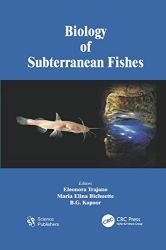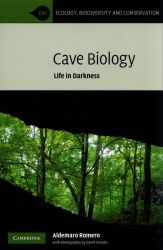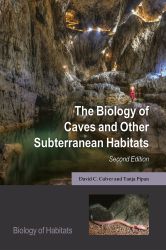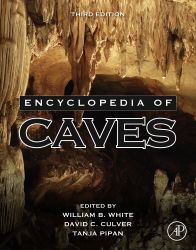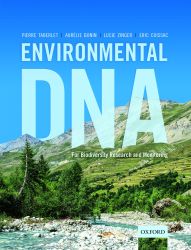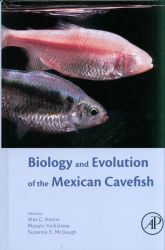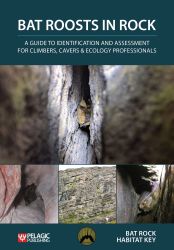8-minute read
keywords: biodiversity, ecology, evolutionary biology
The deep sea is often mentioned as one of the last remaining unexplored areas on the planet, but there is another, closely related world: the subterranean realm of caves. Edited by cave ecologist J. Judson Wynne, Cave Biodiversity brings together fifteen experts in biospeleology to discuss several notable invertebrate and vertebrate groups. A scholarly yet readable overview, this is a welcome addition to the small number of books on this topic.
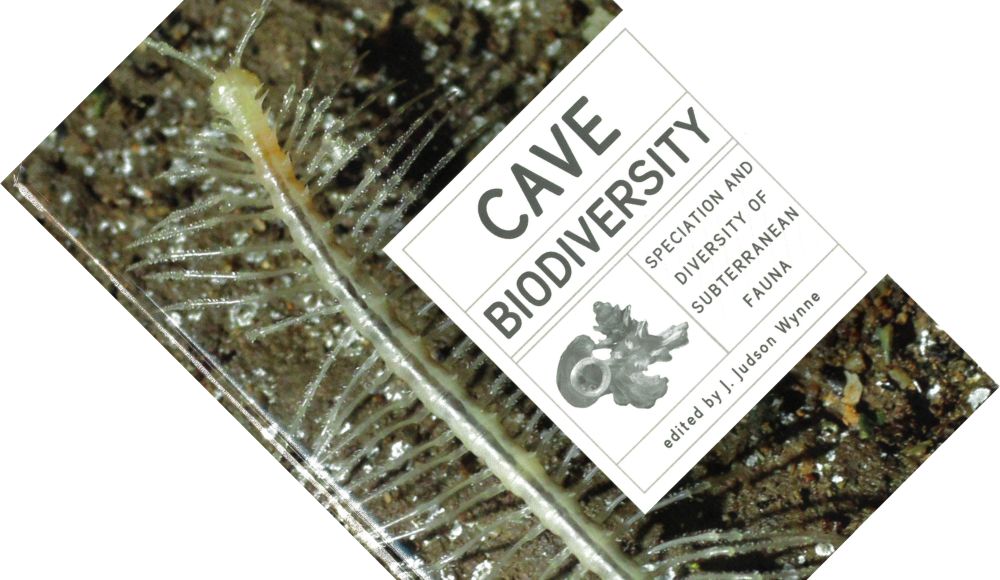
Cave Biodiversity: Speciation and Diversity of Subterranean Fauna, edited by J. Judson Wynne, published by Johns Hopkins University Press in February 2023 (hardback, 327 pages)
Cave Biodiversity is divided into two parts. The core of the book is the five chapters that discuss subterranean molluscs, two groups of cave beetles, cave salamanders, and cavefishes (the only group for which there is a previous dedicated book). It seems two factors played into this selection: Do we know enough about these groups to write a substantial chapter? And has knowledge of these groups so far been scattered in numerous journal papers?
This core is preceded by two chapters providing a general introduction. If, like me, you have not read Cave Biology, The Biology of Caves and Other Subterranean Habitats, or Encyclopedia of Caves, the first chapter is particularly welcome (though be warned, I want to read these books now). It familiarises you with the basic principles of how cave environments shape life underground and explains principles and terminology used throughout the rest of the book. Though no glossary is provided, you will come out understanding the difference between troglobionts, troglophiles, and trogloxenes (i.e. from more to less specialized in cave life; the prefix stygo- instead of troglo- is used for the aquatic counterparts). It explains the basic mechanisms of cave formation and the different environments, from the entrance to the deepest zones where the air is stagnant and humid. It points out that caves come in different sizes and that you need to think of them more in terms of interconnected networks of fissures, voids, and cracks at different scales, many of which are simply too small for human access. And it discusses a long list of biotic and abiotic factors that influence caves both positively and negatively. What stands out is the importance of events at the surface. For example, nutrients enter caves as a steady stream of biological material such as leaf litter, bat guano, and the delightfully named frass (insect poop and related material). At the same time, aboveground changes such as erosion, deforestation, dam construction, etc. negatively impact underground hydrology and climate.
“edited collections […] can either end up as a dumping ground for unrelated technical articles, or they can offer valuable summaries. […] Cave Biodiversity firmly falls into the latter camp”
The second chapter offers a very interesting overview of different models of speciation. How does cave life become established? A popular model is that caves host ice-age relics that evolved from surface organisms that took shelter in caves during interglacial periods. However, many other scenarios are possible. Speciation can occur after species become established underground; there are different degrees of spatial overlap; and different degrees of genetic exchange with existing species at the surface. And did a single, widespread surface species initially colonize several caves and give rise to different isolated cave populations; or do isolated cave populations reflect multiple, independent colonizations by different surface species? There is, perhaps not surprisingly, convergent evolution aplenty, which complicates our attempts at finding answers. Note, also, how caves resemble islands, meaning principles of island biogeography apply. Given my background in evolutionary biology, I gobbled this chapter up.
Now here is the thing about edited collections: depending on the nature of the contributions they can either end up as a dumping ground for unrelated technical articles, or they can offer valuable summaries. I am happy to report that Cave Biodiversity firmly falls into the latter camp and Wynne undoubtedly played an important role behind the scenes as editor. You cannot tell that three chapters have non-native English speakers as the first or only author, and the overall readability and flow are excellent. Despite this being an academic book, none of these chapters loses themselves in obscure technical detail (though they provide plenty of references to papers containing these), and all make liberal use of headings and subheadings to organise their thoughts. I particularly appreciated Grego’s chapter on molluscs and Niemiller et al.‘s chapter on salamanders for providing complete coverage of a large taxon. The chapter on cavefishes is restricted to China, though this fauna is particularly rich and most books on this topic are in Chinese (except for one translated work), so this is a welcome overview. In comparison, the two chapters on beetles seem rather specialist, covering the subfamily Cholevinae of Italy and the subfamily Trechinae of Eastern North America. The latter has a particularly interesting discussion on competing hypotheses to explain their evolutionary history and current species distribution.
For each group, these five chapters discuss what we know about their taxonomy, morphological adaptations, habitats and ecology, diversity and distribution, and colonization and adaptation. Two overarching themes emerge. First is just how hard it is to study these organisms, and how little we know about the biology of many species. Many invertebrates largely live in so-called mesocaverns: the network of fissures and voids that are too small for us to access. Several authors caution that observed distribution patterns and presumed endemicity (an endemic is a species unique to a single location) likely reflect sampling bias and research effort. Much of this field is still in the descriptive stage of simply cataloguing what is out there. Second are conservation concerns, something each chapter concludes with and Stuart Pimm also highlights in his foreword. With nutrients being limited, life underground happens in the slow lane, making these ecosystems particularly vulnerable to human disturbances. The threats are many and diverse: mining, deforestation, groundwater pollution, illegal harvesting for animal trade, cave tourism, and so on. Few environments have been assessed, many species are found to be data deficient (meaning there is too little information to decide if species are endangered), and few countries have conservation legislation in place or prioritize protection of the subterranean biosphere. Species are winking out of existence before we even had a chance to describe them, meaning that caves are at the forefront of unknown biodiversity loss.
“With nutrients being limited, life underground happens in the slow lane, making these ecosystems particularly vulnerable to human disturbances.”
In light of these conservation concerns, I have two minor points of critique. First, I am surprised the book does not make more out of environmental DNA (eDNA). Organisms leave behind a trail of DNA in their environment through e.g. skin cells, hairs, urine, faeces, and whatever else they shed and excrete. In recent years, scientists have explored this as an alternative to direct sighting or trapping in biodiversity surveys. This topic only comes up in the chapters on salamanders (for whom it has been successfully used) and cavefishes (where it still needs to be developed in the Chinese context). Niemiller, who co-authored these chapters, has published elsewhere on the use of eDNA for sampling crayfish and cavefish, cautioning it can complement, but not replace, traditional surveys. But what of invertebrates? A cursory search turned up a recent paper
on the use of eDNA for sampling crayfish and cavefish, cautioning it can complement, but not replace, traditional surveys. But what of invertebrates? A cursory search turned up a recent paper![]() by a group of Italian scientists that explored the use of eDNA from insects and springtails. A more in-depth discussion of this subject would have been an additional cherry on this cake.
by a group of Italian scientists that explored the use of eDNA from insects and springtails. A more in-depth discussion of this subject would have been an additional cherry on this cake.
A second minor critique I have is that two notable groups are absent, though both omissions are understandable. There is no discussion of Mexican cavefishes; then again, there has been a dedicated book on this topic in 2015. And what of bats? Obviously, bats are a huge topic, and there are no troglobionts in this group; they merely roost in caves and are mentioned here for the nutritious guano they leave behind. I wonder if, much like charismatic mammals elsewhere, bats could act as flagship species in cave protection.
Finally, who is this book for beyond the small community of biospeleologists? The focus on speciation and biodiversity makes this of interest to both evolutionary and conservation biologists. But what about recreational cavers? That depends on your background and interests. Cave Biodiversity is a pricey and academic book, though, as mentioned, accessibly written. It certainly should be in the reference libraries of caving clubs. Overall, I consider this to be a very welcome addition to the existing literature, especially in providing several global overviews.
Disclosure: The publisher provided a review copy of this book. The opinion expressed here is my own, however.
Other recommended books mentioned in this review:
__________________________________________________________________
__________________________________________________________________
__________________________________________________________________


